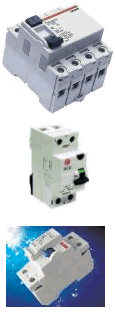 |
Phone: +44 (0)161 928 4719
Email: info@costelloselectrical.co.uk
|
 |
|
|
|
 |

 |
 Power Breakers - Residual Current Device (RCD) Power Breakers - Residual Current Device (RCD) |
 |
 |
|
|
|
|

 What is an RCD
What is an RCD
A Residual Current Device (RCD) can reduce the likelihood of an electrical injury but a shock can still cause very serious or fatal injuries, so an RCD should only be used as a secondary means of reducing the risk of people being injured by electricity.
The best place for an RCD is built into the main switchboard, as this means that the electrical supply is permanently protected. If this is not possible, an electrical outlet incorporating an RCD, or a plug in RCD adaptor, can also provide additional safety.
An RCD detects some, but not all, faults in the electrical system and rapidly switches off the supply, reducing the potential for injury caused by a common type of electric shock. To reduce the likelihood of injury to people the RCD should have a tripping current of not more than 30 milliamps (mA). RCDs with higher tripping currents are unlikely to prevent injuries to people, but can protect against fire.
Please Remember:
An RCD is a valuable safety device, never bypass it; if the RCD trips, it is a sign there is a fault. Check the system before using it again; if the RCD trips frequently and no fault can be found in the system, consult the manufacturer of the RCD; the RCD has a test button to check that its mechanism is free and functioning. Use this regularly.
If lighting circuits are protected by the same RCD that also protects other equipment, a fault that causes the RCD to trip will also result in the loss of lighting that could give rise to a number of risks (such as trips and falls or the dangers from moving machinery). You should perform a risk assessment to identify the effect of fitting an RCD to electrical circuits.
|
|
|
|
|